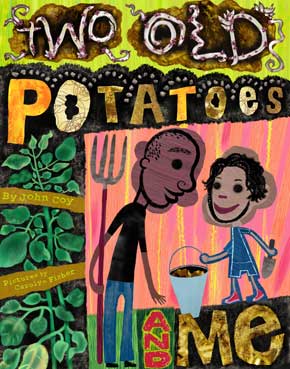 This month’s author interview is with Minneapolis author John Coy. I first learned about him from reading his middle grade novel Crackback. It turns out that in addition to YA and middle grade work, he’s authored a number of picture books, too, on a variety of topics. Along the way, John received numerous awards for his writing including a Marion Vannett Ridgway Award for best first picture book, a Charlotte Zolotow Honor, a Bank Street College Best Book of the Year, and the Burr/Warzalla Award for Distinguished Achievement in Children’s Literature.
This month’s author interview is with Minneapolis author John Coy. I first learned about him from reading his middle grade novel Crackback. It turns out that in addition to YA and middle grade work, he’s authored a number of picture books, too, on a variety of topics. Along the way, John received numerous awards for his writing including a Marion Vannett Ridgway Award for best first picture book, a Charlotte Zolotow Honor, a Bank Street College Best Book of the Year, and the Burr/Warzalla Award for Distinguished Achievement in Children’s Literature.
Yeah, OPB is pretty excited to hear what he’s got to share. With that, let’s all find out together!
Website: https://johncoy.com/pages/about/index.html
Facebook: https://www.facebook.com/John-Coy-Author-106528552773090/
Twitter: https://twitter.com/johncoy23
Instagram: https://www.instagram.com/johncoy23/
 RVC: Let’s start with a can’t‑miss question. Clearly you love sports, having written the 4 for 4 middle-grade series and picture books such as Hoop Genius: How a Desperate Teacher and a Rowdy Class Invented Basketball and Strong to the Hoop. Why do sports topics/issues translate so well into stories for kids?
RVC: Let’s start with a can’t‑miss question. Clearly you love sports, having written the 4 for 4 middle-grade series and picture books such as Hoop Genius: How a Desperate Teacher and a Rowdy Class Invented Basketball and Strong to the Hoop. Why do sports topics/issues translate so well into stories for kids?
JC: The drama. I played lots of sports as a kid and I’m amazed how the details of particular games stick with me all these years later. Sports provide a heightened atmosphere and that translates into good tension for stories.
RVC: When did you first realize you wanted to write picture books?
JC: At the Roseville Library in Minnesota when I was thirty-two years old. I was looking at books with my five-year-old daughter and I had mine and she was still looking. I’d been reading tons of picture books with her and was fascinated by how much was possible with the form. I went over to the computer and typed in my own name to see if anybody named John Coy had written a book. The result came back “Zero books by this author.” I realized if I wanted something to come up I needed to actually write a story.
RVC: In your bio at the Scholastic books site, it says that you’ve worked “as a dishwasher, mattress maker, tour guide, and group home worker before taking up writing.” Which of those proved most useful in terms of helping you become a successful writer?
JC: I love this question. All of them helped, but the tour guide job was the one most directly connected since giving a good tour is all about having great stories. And great stories come from reading, listening to people, conducting research, and then distilling that information to a memorable story. In terms of school visits, though, the group homework continues to be the most valuable as I learned how to connect and work with many different people.
 RVC: Describe the process of how a picture book emerges for you, from the kernel of an idea to the final product that you send on to an acquisition editor (who surely has their own requested tweaks, revisions, and adjustments). By way of example, how about we examine the genesis story of Two Old Potatoes and Me? What’s the seed-to-plant process there?
RVC: Describe the process of how a picture book emerges for you, from the kernel of an idea to the final product that you send on to an acquisition editor (who surely has their own requested tweaks, revisions, and adjustments). By way of example, how about we examine the genesis story of Two Old Potatoes and Me? What’s the seed-to-plant process there?
JC: This one has an interesting origin. In 1999, I was getting married in England and going to be in Europe for five weeks. I needed something to plant in my plot at the community garden that was hardy and could survive while I was gone, so I planted the entire area in potatoes. When I came back, the plot was full of weeds but the potatoes were doing fine. In the fall, I had so many potatoes so I gave some away to friends. One of them–Norton Stillman–called me and told me how good they were. “You should write a book about growing potatoes,” he said.
The next day I started writing about potatoes and then revised and revised it. I sent it to one editor who liked it but rejected it on the grounds that they already had a book about green beans, a vegetable quota I was unaware of. The second editor, Andrea Cascardi at Crown, said yes. Three illustrators turned down the chance to illustrate it, which turned out to be fortunate because we got Carolyn Fisher who created stunning art, including a copyright page with text in the shape of a potato with one sprout thanking Norton Stillman for the idea.
RVC: Two Old Potatoes and Me uses a memorable rhythmic text throughout. What are your feelings on rhyme? And how important is the sound of a picture book to you?
JC: Rhyme is tricky and I’m in awe of folks who do it well. Sound is key to picture book text since the book is designed to be read by an adult to a child. I read stories aloud over and over as I’m working on them. I also record them and hear new things when I listen to the recordings that help make changes.
RVC: What type of rituals or routines are part of your writing process?
JC: Yoga to start the day, breakfast, then some newspapers online. and NBA highlights for procrastination. I try to stay away from email until the afternoon in order to keep space for writing.
RVC: Writing advice is fairly easy to find, and it often consists of the same basic things—write more, read more, revise more, etc. What’s the most unexpected bit of useful advice you have for aspiring authors?
JC: I don’t know if it’s unexpected, but the best advice for me came from the poet Diego Vazquez, Jr.: writers write. For me, that’s important to repeat regularly. Writers write.
I see many aspiring writers spending huge amounts of time trying to understand the business of publishing. Writers write. I think the most important aspect of writing is to write compelling stories.
Writers write.
RVC: Since we mentioned the submission process, let’s get your take on this question that many aspiring writers have. How vital is it for picture book writers to be represented by a literary agent?
JC: I did not have an agent for my first four picture books. Then my editor Andrea Cascardi decided to be an agent after her son was born. He just turned twenty-one and Andrea is still my agent. She knows more about this than I do, so here’s her answer:
“Speaking as an agent, I would have to say it’s about getting access. Most of the large houses don’t accept unsolicited manuscripts. That said, if a writer attends conferences where editors agree to read submissions from attendees or if they do online workshops where editors speak and also agree to read submissions, there are ways to get in the door.”
RVC: Knowing all you now know, what’s one thing you’d have done differently in terms of your writing career way back when?
JC: I would’ve started earlier. The worst piece of advice I heard was that if you don’t have to write every day, then you aren’t a writer. I didn’t feel I had to write every day. so I thought I wasn’t a writer. That and fear of rejection kept me from starting sooner.
RVC: What’s next for you, picture-book-wise?
 JC: Two picture books I started over twenty years ago. On Your Way, beautifully illustrated by Talitha Shipman, comes out August 13. It’s a celebration of first steps and the various ways we learn to move.
JC: Two picture books I started over twenty years ago. On Your Way, beautifully illustrated by Talitha Shipman, comes out August 13. It’s a celebration of first steps and the various ways we learn to move.
In October, My Mighty Journey: A Waterfall’s Story will be published. It’s the story of the only major waterfall on the Mississippi River and what it has witnessed over the past twelve thousand years. It’s first-person waterfall, a type of story we don’t have enough of. Gaylord Schanilec and a team of artists collected material from the riverbank and made striking art with it.
In spring of 2020, two new books will be published. If We Were Gone will be released on the fiftieth anniversary of Earth Day and imagines a world without people. Natalie Capannelli, in her picture book debut, created great pictures for that and it will have a different dust jacket and cover. Then for Father’s Day, Dads, my second collaboration with the award-winning photographer Wing Young Huie, will be released.
RVC: Congrats on so much success! We’ll keep an eye out for those titles here at OBP.
Now–just one last question for this part of the interview. There’s an audio recording at Teaching Books.net where you explain exactly how to pronounce your name. How common of an issue is this for your readers and/or during school visits? I ask because I’ve got a potentially tricky name to get right, too, for a variety of reasons. Inquiring minds want to know!
JC: This is a great service from Teaching Books. I’m surprised how many schools check it out in advance of visits even with my simple name.
RVC: Alright, it’s time for … THE SPEED ROUND! Cheetah-fast questions followed by Ferrari-fast answers, please. Ready?
JC: Ready!
RVC: If I never became a writer, I’d have been a ___________.
JC: frustrated writer.
RVC: Most likely to appear in a future John Coy book—dinosaurs, ninjas, or pirates?
JC: Dinosaurs right now.
RVC: The Princess Bride. Great 80s movie or the greatest 80s movie?
JC: Great 80s movie.
RVC: Which is more satisfying—a book’s birthday or an idea for a new book?
JC: Idea. That’s when the fun begins.
RVC: Favorite picture book by an author not named John Coy?
JC: Kao Kalia Yang’s A Map into the World, which comes out in October. I love it.
RVC: Coolest thing a kid said to you during a school visit?
JC: “Thank you for coming to our school.” That never gets old and goes straight to my heart.
RVC: Thanks so much, John!

